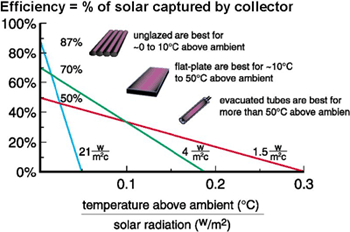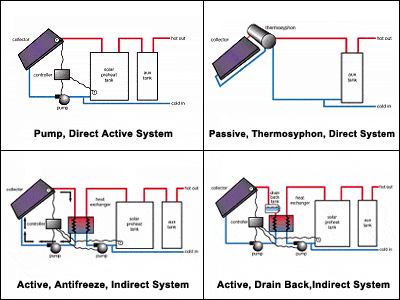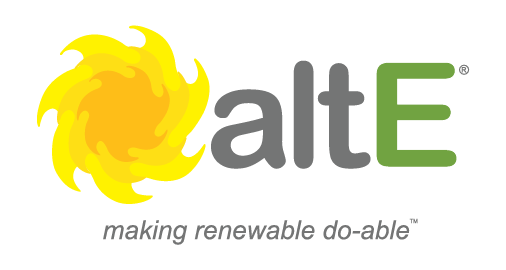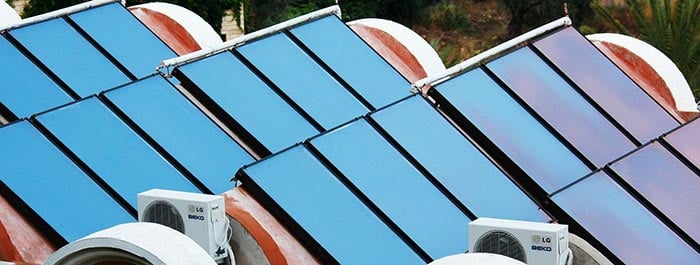Nationwide, approximately 18% of energy use in residential buildings and 4% in commercial buildings is for water heating. Solar water heating systems, which uses the sun’s energy rather than electricity or gas to heat water, can efficiently provide up to 80% of the hot water needs—without fuel cost or pollution and with minimal operation and maintenance expense. Solar currently represents 1% of the water heating market (about 3% of buildings have solar and it provides about 1/3 of the energy for each). In 2003, 11.4 million sq. ft. of collector area were delivered by 27 manufacturers. Most of these were unglazed collectors for swimming pools, a very cost-effective application.
Solar water heating systems can be used effectively throughout the United States at residences and facilities that have an appropriate near-south-facing roof or nearby unshaded grounds for installation of a collector. They are most cost-effective for facilities with the following characteristics:
- Water heating load that is constant throughout the year (not vacant in summer);
- Water heating load is constant throughout the week (to utilize solar heat every day);
- Cost of fuel used to heat water is high (more than $10/Mmbtu or 40.034/kWh), such as electricity, which represents 46% of the water heating market, or propane which represents 2% of the market in remote locations; and/or
- A sunny climate helps but is not required. In 2003, the three largest markets were Florida, California, and New Jersey.
Examples include swimming pools, residences, hotels, laundries, prisons, and kitchens.
Introduction to Solar Water Heating Systems
Solar water heating is a reliable and renewable energy technology used to heat water. Sunlight strikes and heats an “absorber” surface within a “solar collector” or an actual storage tank. Either a heat-transfer fluid or the actual potable water to be used flows through tubes attached to the absorber and picks up the heat from it. (Systems with a separate heat-transfer-fluid loop include a heat exchanger that then heats the potable water.) The heated water is stored in a separate preheat tank or a conventional water heater tank until needed. If additional heat is needed, it is provided by electricity or fossil-fuel energy by the conventional water-heating system.
Although solar water heating systems all use the same basic method for capturing and transferring solar energy, they do so with three specific technologies that distinguish different collectors and systems. The distinctions are important because different water heating needs in various locations are best served by certain types of collectors and systems.
Materials and components used in solar water heating systems vary depending on the expected operating temperature range.
Low-temperature unglazed systems operate at up to 18°F (10°C) above ambient temperature, and are most often used for heating swimming pools. Often, the pool water is colder than the air, and insulating the collector would be counter-productive. Low-temperature collectors are extruded from polypropylene or other polymers with UV stabilizers. Flow passages for the pool water are molded directly into the absorber plate, and pool water is circulated through the collectors with the pool filter circulation pump. Swimming pool heaters cost from $10 to $40/sq. ft. [2004].

Small sample of unglazed low temperature solar collector showing flow passages and header pipe.
Mid-temperature systems produce water 18 to 129°F (10 to 50°C) above outside temperature, and are most often used for heating domestic hot water (DHW). However, it is also possible to use mid-temperature solar hot water collectors for space heating in conjunction with fan-forced convection or radiant floors.
Mid-temperature collectors are usually flat plates insulated by a low-iron cover glass and fiberglass or polyisocyanurate insulation. Reflection and absorption of sunlight in the cover glass reduce the efficiency at low temperature differences, but the glass is required to retain heat at higher temperatures. A copper absorber plate with copper tubes welded to the fins is used. In order to reduce radiant losses from the collector, the absorber plate is often treated with a black nickel selective surface, which has a high absorptivity in the short-wave solar spectrum, but a low-emissivity in the long-wave thermal spectrum. Mid-temperature systems range in cost from $90 to $120/sq. ft. [2004] of collector area.

Small sample of mid-temperature flat plate collector showing cover glass, insulation, and copper absorber plate and flow passages.
High-temperature systems utilize evacuated tubes around the receiver tube to provide high levels of insulation and often use focusing curved mirrors to concentrate sunlight. High temperature systems are required for absorption cooling or electricity generation, but are used for mid-temperature applications such as commercial or institutional water heating as well. Due to the tracking mechanism required to keep the focusing mirrors facing the sun, high-temperature systems are usually very large and mounted on the ground adjacent to a facility. Evacuated tube collectors themselves cost about $75/sq. ft., but use of curved mirrors and economies of scale get this cost down for large system sizes to a relatively low cost of $40-70/sq. ft. [2004].

Close-up view of an evacuated glass tube with black copper absorber plate inside.
Components of a Solar Water Heating System
Solar Collectors – Solar collector efficiency is plotted as a straight line against the parameter (Tc-Ta)/I, where Tc is the collector inlet temperature (in °C), Ta is the ambient air temperature (in °C), and I is the intensity of the solar radiation (W/sq. m.). Notice that inexpensive, unglazed collectors are very efficient at low ambient temperatures, but efficiency drops off very quickly as temperature increases. They offer the best performance for low temperature applications, but glazed collectors are required to efficiently achieve higher temperatures.

In addition to solar collectors, all solar hot water systems have thermal storage, system controls, and a conventional back-up system.
Thermal storage – Storage is generally required to couple the timing of the intermittent solar resource with the timing of the hot water load. In general, 1 to 2 gallons of storage water per square foot of collector area is adequate. Storage can either be potable water or non-potable water if a load side heat exchanger is used. For small systems, storage is most often in the form of glass-lined steel tanks.
Controls – Active systems have a “delta T” (temperature differential) controller to start and stop the pumps. If the temperature in the solar collector outlet exceeds the temperature in the bottom of the storage tank by a set amount (say, 6°C), the controller starts the pump. When this temperature difference falls below another set value, say 2°C, the controller stops the pumps. The controller will also have a high-limit function to turn off the pumps if the temperature in the storage tank exceeds a third setting, say, 90°C. Due to the simplicity and low cost of a delta-T controller, it is wise to keep controls independent of any whole-plant energy management system, although it is desirable to include some indication of system performance, such as output from a BTU meter or preheat tank temperature in the building control system.
Conventional Back-Up Heater – Solar water heaters save energy by preheating water to the conventional heater. Solar DHW systems are usually designed to meet 40% to 70% of the water-heating load. A back-up, conventional heater is still needed to meet 100% of the peak hot water demand for cloudy days or for when the solar system is down for service.
Types of Solar Water Heating Systems
Solar water heating system types are classified as follows:

Active – Requires electric power to activate pumps and/or controls.
Passive – Relies on buoyancy (natural convection) rather than electric power to circulate the water. Thermosyphon systems locate a storage tank above the solar collector, while integrated-collector-storage collectors place the storage inside the collector.
Direct – Heats potable water directly in the collector.
Indirect – Heats propylene glycol or other heat transfer fluid in the collector and transfers heat to potable water via a heat exchanger.
Design of a Solar Water Heating System
Solar water heating systems should be designed to minimize life-cycle cost. It is never cost-effective to design a system to provide 100% of the load with solar because of the excessive investment in collector area and storage volume. Minimize life-cycle cost by designing a system that meets 100% of the load on the sunniest day of the year. Such a system will usually produce about 70% of the annual load. Other design considerations include maintenance, freeze protection, overheating protection, aesthetics of the collector mount, and orientation. Also, utility rebate programs may impose additional design requirements. For example, a solar water heating system must meet 90% of the load in order to qualify for Hawaiian Electric Company rebates.
Steps in designing a solar water heating system include:
- Properly locate the solar collectors – The best annual energy delivery is achieved by facing toward the equator with a tilt up from the horizontal equal to the local latitude. Recent studies show that adequate performance may be obtained with tilt angles and orientations that vary from this considerably. In the continental United States, for maximum performance, collectors should be rotated within 30° of true (not magnetic) south. Also, optimize the tilt of the collecting array. Surfaces tilted up from the horizontal at an angle of latitude minus 15° maximize summer solar gains, but reduce winter gains. Surfaces tilted up at latitude plus 15° maximize winter solar gains and result in a solar delivery that is uniform throughout the year; such a tilt angle may be the best choice for solar water heating systems, as it can reduce the risk of summertime overheating while maximizing use of limited wintertime sunlight. It is usually acceptable to mount the collectors flush on a pitched roof close to the optimal orientation as possible in order to reduce installed cost and improve aesthetics. Resource maps and tables of solar resource information throughout the U.S. are posted at the Solar Radiation Resource Information Center.
- Protect against freezing – Damage can be caused if water freezes in the collector flow passages or connecting piping. There are several strategies for prevention of freeze damage. The most common is to circulate a solution of propylene glycol (never use toxic ethylene glycol) and water in the collector loop of an indirect system. Another strategy is to drain the water from the collector back into a small drain-back tank. This drain-back configuration has the added advantage of protecting the system from excessive temperatures if hot water consumption is reduced due to seasonal use patterns, remodeling, or vacations. Where freezing is uncommon, a controller function that simply circulates water in the collector loop when temperatures approach freezing in conjunction with freeze protection values may be adequate.
- Provide a tempering valve and bypass capability – The tempering valve is very important to assure consistent temperature water is delivered at the taps. Bypass piping and valves allow the conventional system to provide hot water if the solar heating system is down for any reason.
- Provide periodic maintenance for all systems – Check for obvious damage such as broken collector glazing or wet pipe insulation. Check pH and freeze point of heat transfer fluid. Check control temperature sensors against thermometers to be sure sensors are functioning. Check proper pump operation, etc. For a simple comprehensive test, check the preheat tank temperature, it should be hot after a sunny day.
Solar Water Heating System Analysis Tools
Preliminary Screening – To determine if your project is a possible candidate for solar hot water heating, we recommend using NREL’s Windows-based Federal Renewable Energy Screening Assistant (FRESA) software or the more detailed Canadian Retscreen screening tool.
Detailed Performance Once preliminary viability has been established, it will eventually be necessary to evaluate system performance to generate more precise engineering data and economic analysis. This can be accomplished based on hourly simulation software or by hand correlation methods based on the results of hourly simulations. For this task, consider using:
- FCHART, correlation method, available from the University of Wisconsin
- TRNSYS, software, available from the University of Wisconsin
Financing for Solar Water Heating Systems
Utility companies in your area may offer rebates, leases, or other programs that make solar water heating systems more affordable. A complete listing of incentives is provided in the Database of State Incentives for Renewable Energy. It’s also a good idea to check with your utility company directly.
Solar Water Heating System Applications
Consideration should be given to utilizing solar hot water heating systems on all projects where:
- the avoided cost of energy is high (gas not available, electricity rates above $0.034 per kWh),
- there is a dependable, consistent hot water requirement (such as enlisted quarters, laboratories, or hospitals)
- there is a reasonably high daily average solar radiation rate on a tilted surface (in excess of 4.5 kWh/sq. m./day), although if the avoided cost is high enough solar water heating is effective in most climates,
- energy security is important, such as on an international base where energy supplies could be interrupted.
For large facilities, active, indirect systems are most frequently used. For smaller facilities in mild climates with modest freeze threat, passive direct or indirect systems are also a viable option.
Relevant Codes and Standards
The use of solar water heating is consistent with administration directives:
- Executive Order 13123, Section 403(h): “Agencies shall use off-grid generation systems, including solar hot water, solar electric, solar outdoor lighting, small wind turbines, fuel cells, and other off-grid alternatives, where such systems are life-cycle cost-effective and offer benefits including energy efficiency, pollution prevention, source energy reductions, avoided infrastructure costs, or expedited service.”
- Executive Order 12902, Section 304: “The goal of the Federal government is to significantly increase the use of solar and other renewable energy resources.”
- Energy Policy Act of 1992 (EPAct) directs agencies to:
- “include renewable energy [such as solar water heating] along with energy efficiency measures” (Section 542 of the National Energy Conservation Policy Act),
- “demonstrate new technologies, and include environmental benefits such as reduced greenhouse gas emissions in the criteria by which demonstration technologies are selected” (Section 549),
- “include recommendations for cost-effective renewable energy projects” (Section 550).
- Energy Policy Act of 2005



